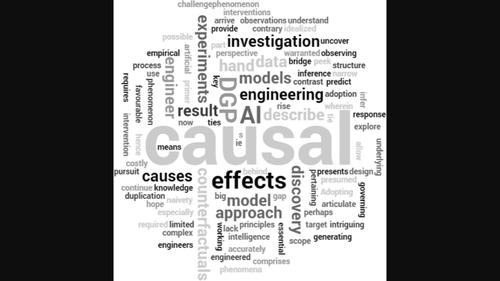Causality and causal inference for engineers: Beyond correlation, regression, prediction and artificial intelligence
引用次数: 0
Abstract
In order to engineer new materials, structures, systems, and processes that address persistent challenges, engineers seek to tie causes to effects and understand the effects of causes. Such a pursuit requires a causal investigation to uncover the underlying structure of the data generating process (DGP) governing phenomena. A causal approach derives causal models that engineers can adopt to infer the effects of interventions (and explore possible counterfactuals). Yet, and for the most part, we continue to design experiments in the hope of empirically observing engineered intervention(s). Such experiments are idealized, complex, and costly and hence are narrow in scope. On the contrary, a causal investigation will allow us to peek into the how and why of a DGP and provide us with the essential means to articulate a causal model that accurately describes the phenomenon on hand and better predicts the outcome of possible interventions. Adopting a causal approach in engineering is perhaps more warranted than ever—especially with the rise of big data and the adoption of artificial intelligence (AI); wherein AI models are naivety presumed to describe causal ties. To bridge such knowledge gap, this primer presents fundamental principles behind causal discovery, causal inference, and counterfactuals from an engineering perspective and contrasts that to those pertaining to correlation, regression, and AI.This article is categorized under: Application Areas > Industry Specific Applications Algorithmic Development > Causality Discovery Application Areas > Science and Technology Technologies > Machine Learning

工程师的因果关系和因果推理:超越相关、回归、预测和人工智能
为了设计出新材料、新结构、新系统和新工艺来应对持续存在的挑战,工程师们力求将原因与结果联系起来,并理解原因的影响。这种追求需要进行因果调查,以揭示支配现象的数据生成过程(DGP)的潜在结构。因果分析方法可得出因果模型,工程师可采用这些模型来推断干预措施的效果(并探索可能的反事实)。然而,在大多数情况下,我们仍在设计实验,希望通过经验观察工程干预。这种实验是理想化的、复杂的、昂贵的,因此范围很窄。相反,因果调查能让我们窥探到危险品管道疏通的方式和原因,并为我们提供必要的手段来阐述因果模型,从而准确描述当前的现象,更好地预测可能的干预结果。在工程学中采用因果关系方法也许比以往任何时候都更有必要--尤其是随着大数据的兴起和人工智能(AI)的采用;人工智能模型被天真地假定为能够描述因果关系。为了弥补这种知识差距,本入门指南从工程学的角度介绍了因果发现、因果推理和反事实背后的基本原理,并将其与相关性、回归和人工智能的原理进行了对比。本文归类于:应用领域 > 行业特定应用算法开发 > 因果发现应用领域 > 科学与技术技术 > 机器学习
本文章由计算机程序翻译,如有差异,请以英文原文为准。
求助全文
约1分钟内获得全文
求助全文

 求助内容:
求助内容: 应助结果提醒方式:
应助结果提醒方式:


